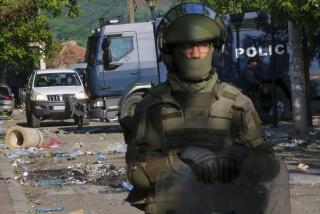Soldiers Use Tear Gas to Avert Kosovo Clash
- Share via
KOSOVSKA MITROVICA, Yugoslavia — As Serbs sang nationalist songs and cheered on their side of this divided Kosovo city, NATO troops battled a surging crowd of about 70,000 ethnic Albanians with tear gas Monday to prevent a potential blood bath.
Ethnic Albanian protesters had marched about 25 miles from Pristina, the provincial capital, to press demands for an end to the division of Kosovska Mitrovica, which they see as part of an attempt to partition Kosovo, a province of Serbia, the dominant Yugoslav republic.
For more than three hours, British and Canadian soldiers, often bent over and choking in pain from clouds of tear gas fired by French gendarmes, struggled to hold their front line on a bridge over the Ibar River, which separates the Serbs from the ethnic Albanians.
Both Serbian and ethnic Albanian extremists have been blamed for stirring up unrest in Kosovska Mitrovica, and while violence has dropped sharply in the rest of Kosovo, the city symbolizes one of the main failures of the NATO-led peacekeeping mission.
Eleven months after the North Atlantic Treaty Organization launched its airstrikes to end Serbian repression of Kosovo’s ethnic Albanian majority, the mission seems as far as ever from building a multiethnic democracy in the province.
The latest violence has left NATO troops in the bizarre, and dangerous, position of defending an iron wall dividing a strategic town that the peacekeepers’ commanders repeatedly have promised to unite.
Violence erupted Monday when ethnic Albanians from Kosovo’s central Drenica region, the birthplace of the separatist Kosovo Liberation Army, broke through a cordon of NATO armored vehicles and barbed wire.
They tried to storm across the bridge to confront about 4,000 waiting Serbs but were repeatedly driven back with volleys of tear gas. Peacekeepers wrestled several ethnic Albanian protesters to the ground and arrested them.
But the rest of the marchers only regrouped, and several dozen managed to swarm on top of at least one NATO armored vehicle. Some of the protesters carried U.S. and U.N. flags in addition to the red-and-black Albanian flag. Peacekeepers estimated the crowd at about 70,000.
Trouble continued after the 6 p.m. nightly curfew, but the crowd eventually dispersed.
As the marchers approached the city earlier Monday, Agim Ceku, former head of the now-disbanded KLA guerrilla force, met with NATO commanders in Kosovska Mitrovica.
Ceku now commands the Kosovo Protection Corps, which NATO set up as a civilian force to deal with natural disasters, rescues and other civil defense in Kosovo. But when NATO called on Ceku to help calm the crowd Monday, he seemed to have a much more important, political role.
The marchers came to Kosovska Mitrovica to help speed up the process of finding a solution to the ethnic division and “also as a message to the whole international community that the division is unacceptable,” Ceku told reporters as he walked next to British and French officers.
Serbian forces committed widespread atrocities against Kosovo’s ethnic Albanian majority and drove hundreds of thousands from Kosovo during 11 weeks of NATO airstrikes. When the ethnic Albanians returned, Serbs and other minorities were attacked and driven from their homes.
Many of the estimated 9,000 Serbs living in the northern part of Kosovska Mitrovica came from other parts of Kosovo because they didn’t feel safe in their home villages and towns.
On Feb. 2, two elderly Serbs died when an antitank rocket was fired at a bus clearly marked with the acronym of the Office of the U.N. High Commission for Refugees and guarded by two French armored vehicles.
No one has been arrested in the attack, which occurred on a foggy stretch of road in a mainly ethnic Albanian region of Kosovo. When Serbs sought revenge in Kosovska Mitrovica, nine people died and scores were injured.
More than 1,000 ethnic Albanians fled the mainly Serbian northern district of Kosovska Mitrovica. Many of them said Serbs had ordered them to leave. But the United Nations says at least 2,000 ethnic Albanians still live under NATO protection in the northern sector.
In southern Kosovska Mitrovica, where about 9,000 ethnic Albanians live, there are just seven Serbs left, and they are holed up in an Orthodox church guarded by French troops.
As violence flared on the main bridge across the Ibar on Monday, about 350 U.S. troops from the 82nd Airborne Division guarded the entrance to a secondary bridge and did not come under attack.
But at least one U.S. soldier on duty in the southern sector had two swollen black eyes and dried blood on the bridge of his broken nose, wounds suffered when Serbs hurled rocks and bottles at American troops searching for illegal weapons Sunday.
The French commander in Kosovska Mitrovica, Gen. Pierre de Saqui de Sannes, ordered the U.S. reinforcements to withdraw from the mainly Serbian district before the weapons search was complete.
By the end of Sunday, NATO troops had confiscated 10 AK-47 assault rifles, 10 older rifles, one Uzi submachine gun, one heavy machine gun, seven boxes of plastic explosives and a hand grenade from northern Kosovska Mitrovica.
The troops reported taking a single handgun from an ethnic Albanian in the southern sector. On Feb. 15, NATO peacekeepers found 10 rocket launchers, 180 grenades and thousands of bullets in an Albanian ambulance abandoned near a NATO roadblock south of the city, leaving little doubt that Kosovo is still awash in illegal weapons on both sides of the ethnic divide.
In the swirl of tear gas Monday, NATO leaflets floated down from helicopters flying low overhead, to deliver a message in Albanian: “Keep cool in this situation, so you remain trustworthy cooperators. Be aware: violence doesn’t serve anyone.”
More to Read
Sign up for Essential California
The most important California stories and recommendations in your inbox every morning.
You may occasionally receive promotional content from the Los Angeles Times.













